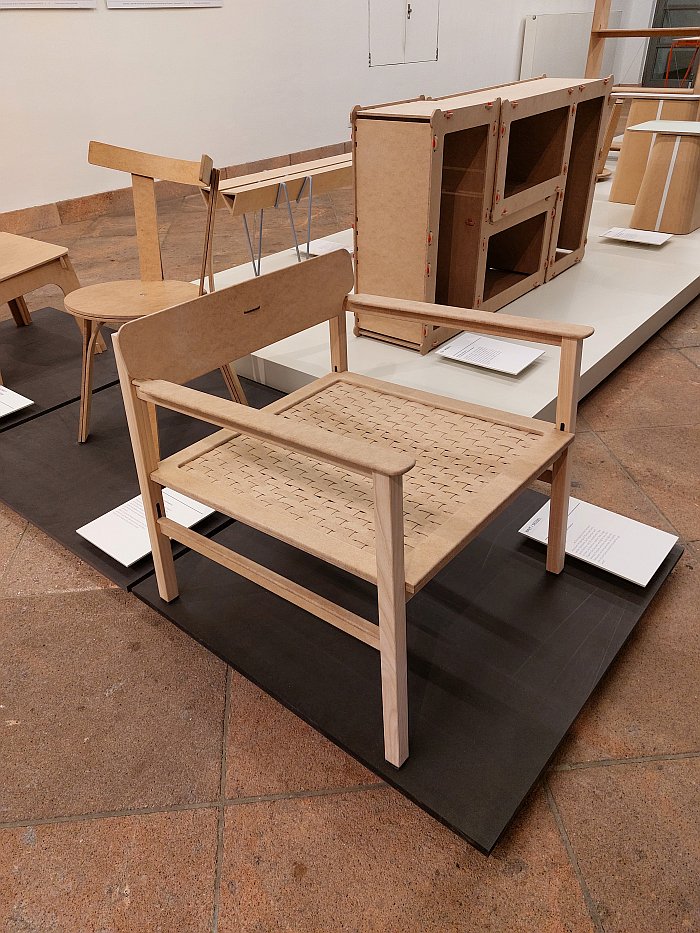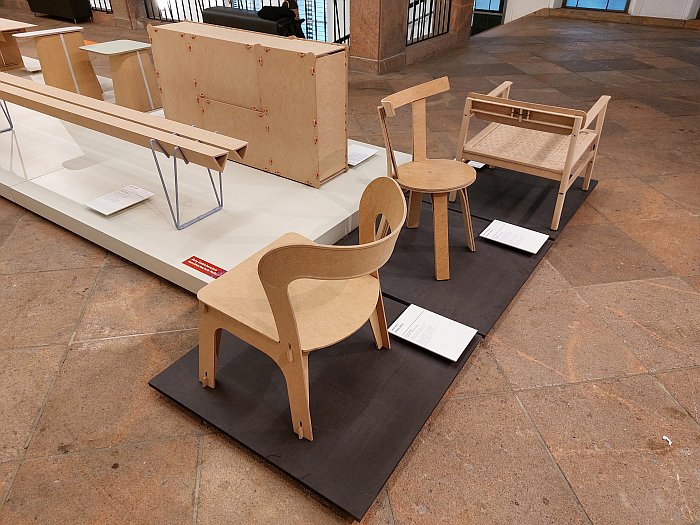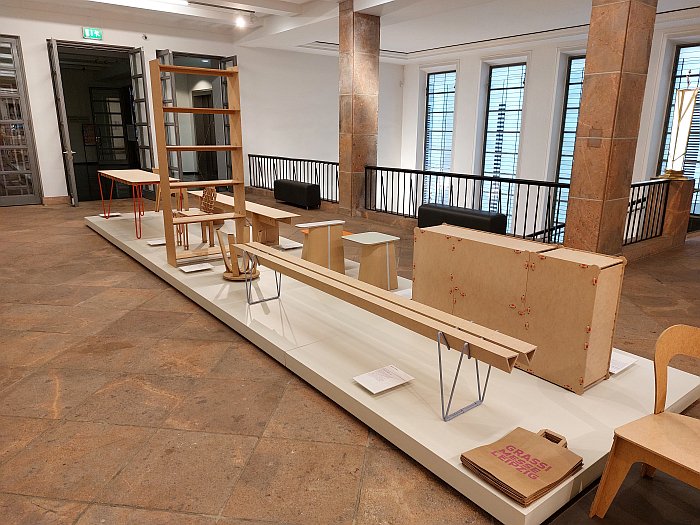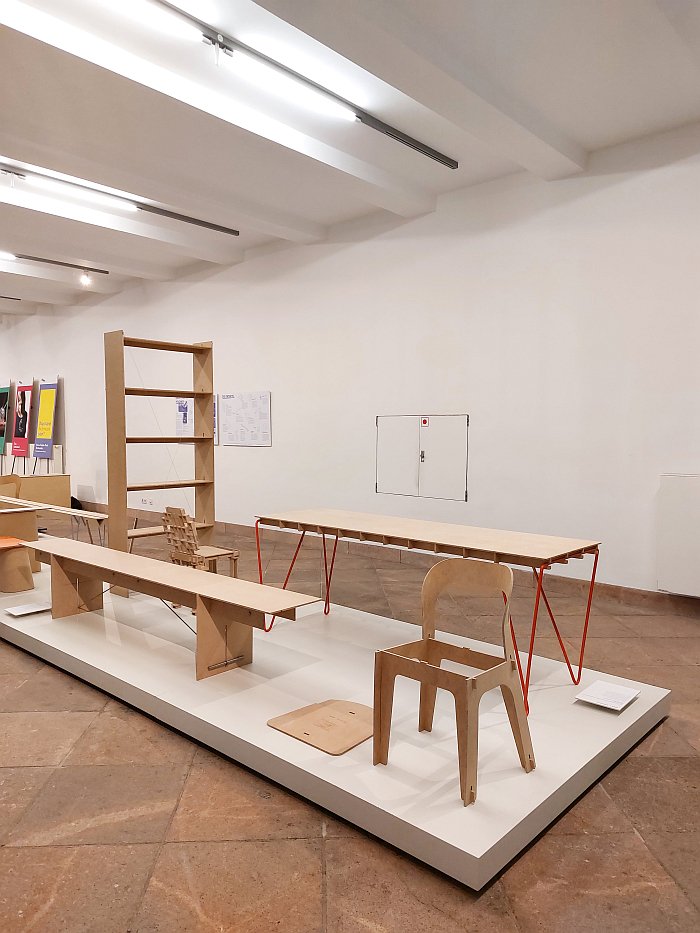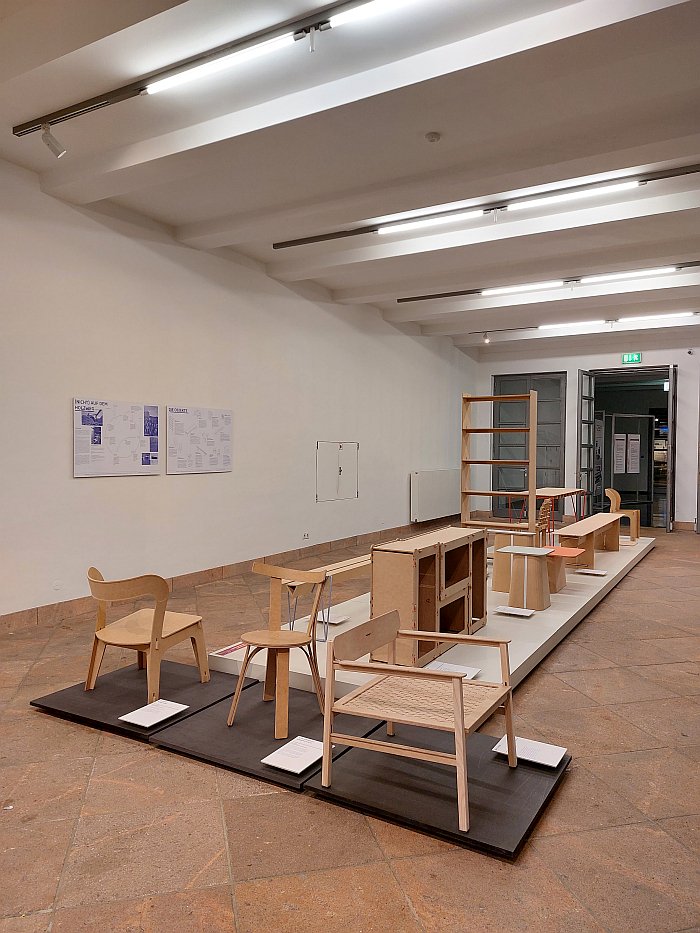
Cutting straight to the chase, in our post from the Burg Giebichenstein Kunsthochschule Halle Jahresausstellung 2023 we noted "as ever we may have missed things, in fact we know we did": the project Faserland oder 8mm und 100% Bio was that thing we knew we'd missed. Whereby we still don't know where it was hidden, for we can't remember a single square centimetre of the Halle campus we weren't on that day.
But miss it we did. Somehow.
Fortunately it is being re-presented at Grassimesse 2023. And no, its not in these dispatches because we missed it, although pathological completists that we are it would make sense if that were the reason; but is here because as a project is interesting and informative in terms of reflections and consideration on, and choices of, materials for furniture and furnishings. And on design eduction.
Staged under the direction of Prof. Klaus Michel Faserland oder 8mm und 100% Bio challenged the students to develop two furniture objects from a novel form of fibreboard, a class of material, arguably, most popularly known as MDF, and a material class which, as the introduction to Faserland oder 8mm und 100% Bio notes, for all the advantages they bring with them, not least in terms of the fact all manner of woods, and parts of trees, can be employed in their creation, do require a binder to hold the re-formed mass together. Binders than are petrochemical based.
Or were.
The so-called FunderPlan board from Austria manufacturer Fundermax is based on a novel production process that employs the resins inherent in the wood as the binder. Thus allowing for a fibreboard that is 100% wood. Additive free. And also is, so we're informed, more pliable and more workable, less likely to rip and crack and fissure, than conventional fibreboards, and that even when employed in much thinner portions: the 8mm of the title referring to the thickness, standard fibreboard's being, as Billy will tell you,19mm. And an increased durability that we're assuming, we don't know, we're assuming, because the use of the natural resins as opposed to added binders allows for a more coherent, more integral, more stable product.
And which all sounds like a very good thing indeed. And which thus is very much an example of a novel material looking for novel, meaningful, applications of its properties.
Which is what Prof. Klaus Michel asked the students to think about while developing two pieces of furniture from FunderPlan
And thus the presentation in the Grassi Museum isn't primarily about the objects presented, although it can be viewed as such, but is much more about how the students approached the novel possibilities offered by the novel material to develop novel solutions, that way novel materials and processes enable developments and evolutions of the existing.
And also a presentation, a presentation in context of the Grassimesse, an institution that Burg Halle have been more or less ever presents at since the inaugural Grassimesse in 1920, that helps elucidate that while back in the day when the Grassimesse was taking its first steps 'design' education was also taking its first steps away from copying that which existed, that training method borrowed from art, to workshops in which students developed their own projects, and their practical skills, and which over time has increasingly incorporated novel materials and processes, according , if one so will, to the motto, 'this is the generation who're going to have to work out what this stuff can do, let's start'. And which all helps underscore that for all design education is without question about acquiring a collection tattoos and developing a Club-Mate addiction, it is also about advancing and challenging and refining the individual students positions to design and understandings of design and a designers function in and relationship to contemporary and future society. And which is why projects such as Faserland oder 8mm und 100% Bio are more than the physical results.
Physical results of which can't mention all, but will note that many seemed to focus on flat-pack systems, and that we had particularly long discussions with the chair Nait by Pepe Nitz which incorporates woven FunderPlan, i.e. woven fibreboard, try that with MDF; the bench Beam by Camille von Gerkan which strikes us an interesting solution for temporary seating; and by the Instant collection by Judith Burgard, which, according to the description, is delivered flat-pack and then "by pouring boiling water over it, the material becomes temporarily formable". No honest! That's what it says. Pour on boiling water. And then when pliable it can be transformed from a flat-pack to, for example, a chair.
And which apart from posing the very obvious question where do you that? Where do you have space in your house to pour boiling water on wood? What are the regulations for doing it in a workplace? And apart from the thoughts it also awakes of a Leo Koda's boiling of 3D printed objects in context of his project In Fill Out, as seen in context of the showcase The Series during Vienna Design Week 2023... apart from all that, is a genuinely fascinating concept, that opens all manner of possibilities for furniture design and the provision of furniture. And also, and given that at the moment FunderPlan is almost exclusively used in building, reminds of the so-called Acrylic modules in Günther L. Eckert’s Kontinuum as discussed in The Tube. An Architecture for Conceivable Times at the Werkbundarchiv – Museum der Dinge, Berlin, and whose walls could be reshaped and reformed into functional and decorative elements with the aid of, essentially, a clothes iron; Eckert's transformable walls were planned in synthetic plastic, but heat formable 100% wood walls as the basis for responsive and customisable interiors is a genuinely fascinating thought. If it's feasible or not, we no know, but it sounds worthy of pursuit. As does hot water formable wooden furniture.
Further information on Faserland oder 8mm und 100% Bio, but sadly not the resulting works, can be found at www.burg-halle.de
And for all in or near Leipzig Faserland oder 8mm und 100% Bio, and projects from the six other international design schools, can be experienced at the Grassimesse, at the GRASSI Museum für Angewandte Kunst, Johannisplatz 5-11, 04103 Leipzig until Sunday 22nd October
Full details of the 2023 Grassimesse, including opening hours and ticket prices, can be found at www.grassimesse.de
